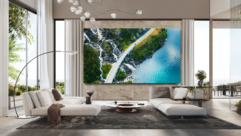
AV Enhances Luxury Home
Working closely with the general contractor, Atlanta-area home automation specialist integrates AV and lighting systems with a truly ?built-in? look.
Working closely with the home’s general contractor, Cumming, GA-based AV integrator HomeWaves had a special cavern built into the wall separating the billards room and the gym area. This way, 42-inch Hitachi CMP4211U plasma monitors could be mounted flush into the walls of both rooms.
CHALLENGE: Design and integrate expansive home theater and intelligent lighting systems in new home with components such monitors and fixtures located flush within walls and ceilings.
SOLUTION: Keep a project manager onsite and maintain constant collaboration with general contractor so that building construction meets AV and lighting needs.
THE LOG BOOKS of AV integrators are full of projects that suffered greatly because electronic systems were installed after the general contractor completed its work.
For Cumming, GA-based home AV and automation integrator HomeWaves Inc., however, a recent install at a new luxury dwelling in nearby Suwanee, GA, shows what can happen when builder and integrator get on the same page early on.
“This is a pretty good example of that relationship working well,” says Adam Weart, manager of design and engineering for HomeWaves, which integrated a robust, multi-display home theater system in the basement of the 2,500-square-foot home, as well as an intelligent lighting system throughout the house.
“There are plenty of examples where the builder is adverse to us, and they want to do all the low-voltage wiring on the job,” explains Weart, whose team handled all the low-voltage electrical work in the basement as well as the electrical wiring for the lighting systems throughout the house. “The biggest challenge on this project was getting all the information to the builder. But because we had been contracted ahead of time, we had the opportunity to talk to the general contractor and tell him what we wanted to do. The whole thing just came down to project management.”
FLUSH-MOUNTING THE FLAT-PANEL DISPLAYS
The SF600 SmartMounts from Peerless list for $53 to $100.
Credit: aland
A common complaint among clients in the home automation sector, according to Adam Weart, is that they’re often surprised to learn that their new flat-panel plasma display doesn’t necessarily rest flat against their walls.
“People want plasmas on the wall, but what they don’t realize is that once you account for the guts of the monitor and conventional mounting hardware, it’s really sitting 8 inches off the wall,” says Weart, design and engineering manager for Cumming, GA-based home AV and automation integrator HomeWaves Inc.
For the home theater/automation project in nearby Suwanee, GA, Weart and his team engineered a novel scheme that allowed them to embed a 42-inch Hitachi plasma monitor flush into the basement wall of a of a luxury home.
Working closely with the new house’s general contractor, HomeWaves had the sheetrock wall that separates the billiards area of the basement from the gym area expanded to 6 inches in depth, instead of the typical 4 inches.
In the billiards area, HomeWaves then had the builder cut a cavern in the wall so that a 42-inch Hitachi CMP4211U plasma monitor could be placed into it and mounted flush with the surface of the wall.
Embedding the plasma not only created a nice, clean aesthetic, but there were also space-saving considerations. “We made it so you don’t see any of the parts behind the TV,” Weart says. “While the client lost 2 inches of space in his exercise room, he gained 4 or 5 inches by having the plasma flush in the wall.”
For mounting, Weart’s team used a set of Peerless SF660 SmartMounts — which can be purchased for anywhere from $53 to $110 — that secured the plasma directly to the studs inside the wall. “The reason we used this mount is because it’s so sleek and thin that you don’t need as much space in the recess of the framing,” Weart says.
Proximity to the job helped — because so many of the components HomeWaves installed required special accommodations in the building process, Weart’s team benefited from being able to conveniently look over the general contractor’s shoulder every day.
“Luckily for us, this project was relatively close to our office, so it wasn’t as difficult to project manage,” Weart says. “We were able to spend a lot more time on the jobsite with the contractor on a day-to-day basis. Basically, our project manager would be on the jobsite when our installers were working and was able to give direction.”
Totaling about $190,000, the project was modest by current home automation standards: “A lot of the projects we’re working on right now total in the millions of dollars,” Weart notes.
It’s aesthetics that set the Suwanee job apart.
For example, the house’s basement includes separate billiards, gym, and bar areas, all equipped with their own dedicated Hitachi plasma display.
Notably, the 42-inch Hitachi CMP4211U monitors in the billiards and gym areas are mounted flush in the wall, embedded into precisely engineered openings that leave only several millimeters of opens space to frame these displays. “It’s the smallest seam you can imagine,” Weart says (see sidebar on page 27).
Home Theater
Adjacent to these areas, HomeWaves designed and installed an eight-seat home theater, built around a Marantz DLP VP12S4 projector, a Marantz DV-9500 DVD player (which serves the three other displays in the basement), a 106-inch Stewart StudioTek 130 screen, and an array of Paradigm speakers (four Reference ADP surround sound speakers wall-mounted in the rear of the theater, plus a pair of Reference S8 towers flanking and a Reference C5 center speaker up front).
Because the ceiling hung a bit too low in this area of the basement, HomeWaves had the builder implement four, square-shaped recessed coffers into the square-shaped ceiling to afford a bit more vertical space.
Additionally, HomeWaves mounted the Marantz DLP unit on a custom-built motorized lift — the projector rests on a retractable panel, placed inside a cavern cut into the lower middle portion of the ceiling that runs between the four coffers.
Using an AMX wireless touchpanel — all home theater systems in the basement are controlled via AMX NT-2000 — the panel descends about 1 foot below the ceiling when the theater is in use.
“When the movie is done, you hit a button, and the projector hides itself back up,” Weart explains.
Here, again, enabling this functionality required close collaboration with the general contractor, who had to design the ceiling so that there was enough room for the projector to fit and operate.
The Light Touch
In addition to the basement AV systems, HomeWaves designed automated lighting for most of the home.
HomeWaves convinced the general contractor to lower large wooden cross-beams in the basement’s bar area several inches from the ceiling. This way, xenon lighting could be mounted on top of these beams for effect.
With the lighting installation, too, coordination with the builder was key. For example, the general contractor originally planned to mount large wooden crossbeams across the ceiling of the basement’s bar area. But HomeWaves convinced him to lower these beams so that there are several inches between beam and ceiling.
This allowed HomeWaves to mount xenon lighting on top of the beams — the actual lighting is invisible at ground level, but creates an effect in the room.
Meanwhile, like the plasma screens, HomeWaves was able to work with the general contractor so that all of the lighting control panels — which included Vantage eight-button Trimline Britetouch panels in areas such as the gym and bathrooms — could be mounted flush inside the walls.
Unfortunately, while the general contractor was just getting started with the basement when HomeWaves first arrived on the scene, it had already finished most of its work in the upper levels of the house.
“One of the main challenges that we faced right away was getting an initial level of lighting automation in the finished areas of the house,” Weart says. “We had to fish wire through the walls to all of the light switches that were on the lighting control system. We also had to add some can fixture lighting to give a more dramatic effect to rooms like the master bedroom, where there was to be art on display.”
Custom Control
While collaborating with the general contractor saved HomeWaves time and effort, and enabled them to come up with innovative, aesthetically pleasing solutions, working closely with the client helped the company customize the right control interface.
For typical home theater installations, HomeWaves programs very easy-to-use AMX NetLinx control interfaces. Early client feedback, however, suggested the Suwanee project called for more granular control.
“He’s a bit more tech savvy when it comes to home theater, so we gave him more control,” Weart explains of the Suwanee home owner. “A lot of our clients don’t like that, but he specifically requested that level of control.”
Meanwhile, HomeWaves customized the AMX controller shells and the interface backgrounds to match the decor of the house.
“They have the same Tuscan look as the rest of the house,” Weart says.
Daniel Frankel is a freelance writer based in Los Angeles. He can be reached at [email protected].
FOR MORE INFORMATION
AMXwww.amx.com
Bay Audiowww.bayaudio.com
Hitachiwww.hitachi.com
Marantzwww.marantz.com
Paradigmwww.paradigm.com
Peerless Industrieswww.peerlessindustries.com
Stewart Filmscreenwww.stewartfilm.com
Vantagewww.vantageinc.com










